- 3.2Impact Factor
- 6.4CiteScore
- 16 daysTime to First Decision
Piezoelectric Materials for Photocatalysis and Electrocatalysis
This special issue belongs to the section “Catalytic Materials“.
Special Issue Information
Dear Colleagues,
Piezoelectric materials, characterized by their ability to generate internal electric fields in response to mechanical stimuli, are opening new frontiers in catalytic science. This strain-induced polarization offers a powerful and often untapped tool to manipulate charge carrier dynamics, band structures, and surface energetics in real-time. By harnessing ubiquitous mechanical energy from the environment—such as ultrasound, flow, or even ambient vibration—these materials can significantly enhance the efficiency of photocatalytic and electrocatalytic processes without solely relying on external electrical bias.
This Special Issue, entitled “Piezoelectric Materials for Photocatalysis and Electrocatalysis”, is dedicated to exploring the latest advancements in leveraging the piezoelectric effect for energy conversion and environmental remediation. We aim to cover the fundamental principles, novel material design, and innovative applications of piezoelectric catalysts. The scope includes, but is not limited to, the following:
- Piezocatalysis for the degradation of pollutants and bacterial disinfection.
- Piezo-photocatalysis systems that synergistically couple mechanical and solar energy for water splitting and CO2 reduction.
- Piezo-electrocatalysis where mechanical strain modulates electrochemical reactions like oxygen evolution/reduction (OER/ORR).
- Advanced characterization and theoretical modelling to decipher the mechanisms of strain-induced charge separation and catalytic activation.
- The design of hybrid and composite materials that integrate piezoelectric with semiconducting or metallic phases for enhanced performance.
We invite the submission of original research articles, reviews, and perspectives that highlight breakthroughs in this rapidly evolving field. By bringing together research from materials science, chemistry, physics, and engineering, this Special Issue seeks to establish the critical role of piezoelectricity in advancing catalytic technologies and to inspire innovative solutions for sustainable energy and environmental challenges.
Prof. Dr. Qi Zhang
Dr. Hugo Salazar
Guest Editors
Manuscript Submission Information
Manuscripts should be submitted online at www.mdpi.com by registering and logging in to this website. Once you are registered, click here to go to the submission form. Manuscripts can be submitted until the deadline. All submissions that pass pre-check are peer-reviewed. Accepted papers will be published continuously in the journal (as soon as accepted) and will be listed together on the special issue website. Research articles, review articles as well as short communications are invited. For planned papers, a title and short abstract (about 250 words) can be sent to the Editorial Office for assessment.
Submitted manuscripts should not have been published previously, nor be under consideration for publication elsewhere (except conference proceedings papers). All manuscripts are thoroughly refereed through a single-blind peer-review process. A guide for authors and other relevant information for submission of manuscripts is available on the Instructions for Authors page. Materials is an international peer-reviewed open access semimonthly journal published by MDPI.
Please visit the Instructions for Authors page before submitting a manuscript. The Article Processing Charge (APC) for publication in this open access journal is 2600 CHF (Swiss Francs). Submitted papers should be well formatted and use good English. Authors may use MDPI's English editing service prior to publication or during author revisions.
Keywords
- piezoelectric materials
- photocatalysis
- electrocatalysis
- charge separation
- polarization effects
- functional oxides
- water splitting
- CO2 reduction
- environmental remediation
- energy conversion

Benefits of Publishing in a Special Issue
- Ease of navigation: Grouping papers by topic helps scholars navigate broad scope journals more efficiently.
- Greater discoverability: Special Issues support the reach and impact of scientific research. Articles in Special Issues are more discoverable and cited more frequently.
- Expansion of research network: Special Issues facilitate connections among authors, fostering scientific collaborations.
- External promotion: Articles in Special Issues are often promoted through the journal's social media, increasing their visibility.
- e-Book format: Special Issues with more than 10 articles can be published as dedicated e-books, ensuring wide and rapid dissemination.

